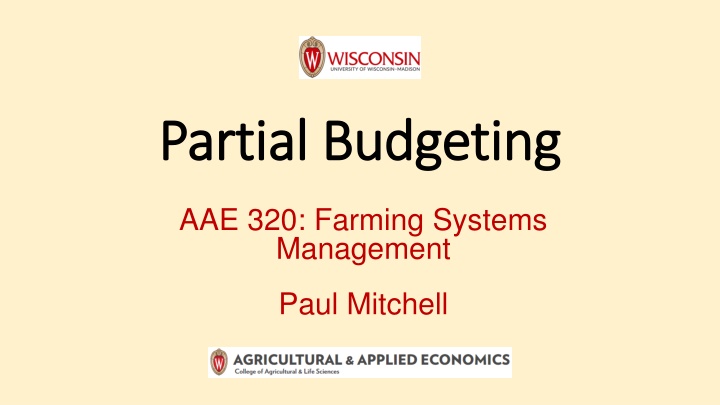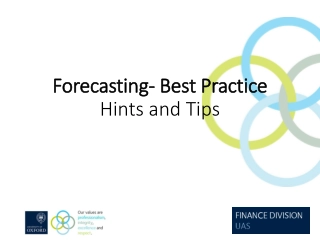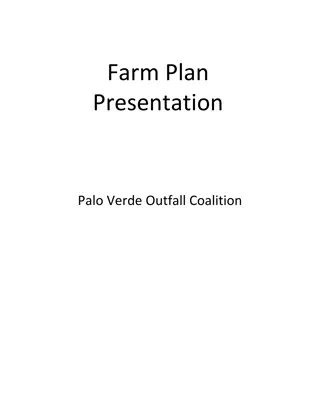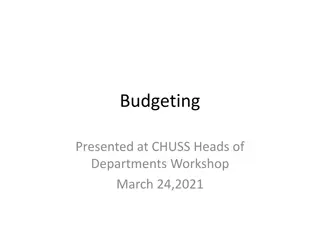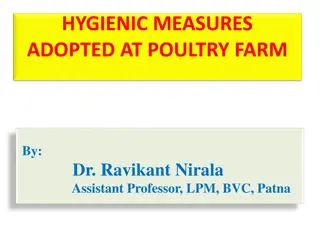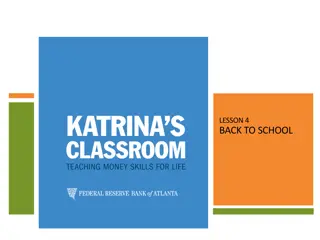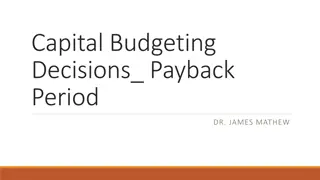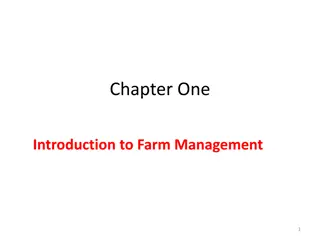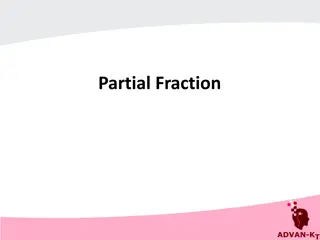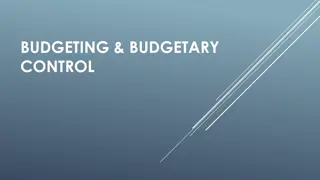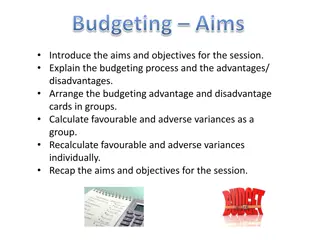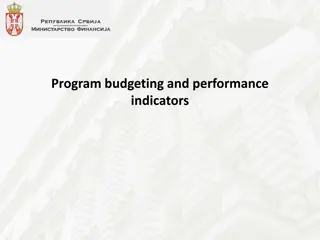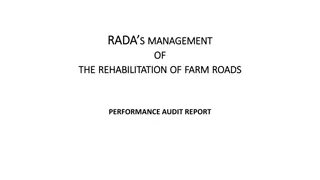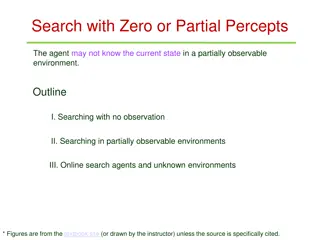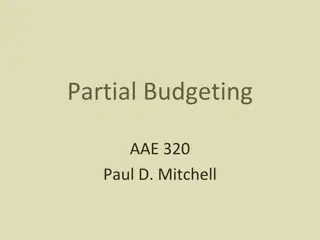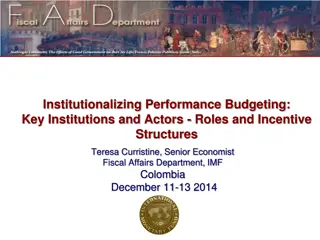Introduction to Partial Budgeting in Farm Management
Understand the purpose and methodology of partial budgets in farm management, focusing on analyzing net gains from small changes or refinements to farm operations. Learn how to build and utilize partial budgets to make informed decisions regarding farm management. Explore examples of farm management decisions suitable for partial budget analysis to optimize profitability. Discover the four key questions to answer when conducting a partial budget analysis to calculate net gain effectively.
Download Presentation

Please find below an Image/Link to download the presentation.
The content on the website is provided AS IS for your information and personal use only. It may not be sold, licensed, or shared on other websites without obtaining consent from the author.If you encounter any issues during the download, it is possible that the publisher has removed the file from their server.
You are allowed to download the files provided on this website for personal or commercial use, subject to the condition that they are used lawfully. All files are the property of their respective owners.
The content on the website is provided AS IS for your information and personal use only. It may not be sold, licensed, or shared on other websites without obtaining consent from the author.
E N D
Presentation Transcript
Partial Budgeting Partial Budgeting AAE 320: Farming Systems Management Paul Mitchell
Learning Goals Learning Goals 1. Understand the purpose of partial budgets in farm management: What sorts of questions do they answer? 2. Understand how to build and use a partial budget
Purpose of Partial Budgets Purpose of Partial Budgets To analyze net gain from small changes or refinements to a farm operation Partial Budget: focuses only on the parts that change. You do not need a complete budget for each enterprise Use to fine tune current operation: Hold all else fixed in order to evaluate small changes Marginal analysis or incremental analysis Can be the first step to decide if want to do more formal or comprehensive analysis
Examples of Farm Management Decisions to Examples of Farm Management Decisions to Examine using Partial Budget Analysis Examine using Partial Budget Analysis Do I apply a foliar fungicide to my corn? Do I buy a combine or continue hiring a custom harvester? Do I pay for a soil test for N on my corn or just use N credits? Do I replace my old silage chopper with a newer one? Do I hire an extra person to help with milking? Do I rent an additional 40 acre field to plant corn? Do I add 25 more cows to my milking herd?
Basic Method: Answer Four Questions Basic Method: Answer Four Questions Benefits: 1) What will be the new or added revenues? 2) What costs will be reduced or eliminated? Costs: 3) What will be the new or added costs? 4) What revenues will be reduced or lost? Partial Budget: Answer these 4 questions and then calculate Net Gain = Benefits Costs
Benefits Costs Additional Revenues What will be the new or added revenues? Additional Costs What will be the new or added costs? Costs Reduced What costs will be reduced or eliminated? Revenues Reduced What revenues will be reduced or lost? Total Benefits Total Costs Calculate Net Gain = Total Benefits Total Costs
Corn/Soybean Planter Example Corn/Soybean Planter Example You custom hire someone to plant 300 acres of corn and 200 acres of soybeans each year. You want to examine buying your own planter. 1. What will be the new or added revenues? Increased yields due to more timely planting 2. What costs will be reduced or eliminated? No longer pay for custom planting 3. What will be the new or added costs? Fixed and variable costs of owning a planter 4. What revenues will be reduced or lost? I can t think of any
Partial Budget: Corn/soybean planter example Benefits Additional Revenues What will be new or added revenues? Increased yields due to more timely planting Costs Additional Costs What will be new or added costs? No longer pay for custom planting Costs Reduced What costs will be reduced or eliminated? Fixed and variable costs of owning a planter Total Benefits Revenues Reduced What revenues will be reduced or lost? I can t think of any Total Costs Calculate Net Gain = Total Benefits Total Costs
Partial Budget: Corn/soybean planter example Benefits Additional Revenues 3 bu corn x $3.00/bu x 300 ac = $2,700 1 bu soybean x $9.00/bu x 200 ac = $1,800 Costs Additional Costs Corn $25/ac x 300 ac = $7,500 Soybeans $24/ac x 200 ac = $4,800 Costs Reduced Custom corn planting $20/ac x 300 ac = $6,000 Custom soybean planting $19/ac x 200 ac = $3,800 Total Benefits Revenues Reduced None $14,300 Total Costs $12,300 Calculate Net Gain = Total Benefits Total Costs $2,000
Corn/Soybean Planter Example Corn/Soybean Planter Example Notice how only focus on the costs and revenues that change Gain 3 bu of corn and 1 bu of soybeans due to more timely planting Corn = 1% loss/day in WI after May 8: http://corn.agronomy.wisc.edu/AA/A002.aspx Soybeans: 0.25/bu/day in IA study: https://crops.extension.iastate.edu/encyclopedia/soybean- planting-date-can-have-significant-impact-yield Estimate cost of owning and operating a planter: Estimating Farm Machinery Costs (ISU Extension) https://www.extension.iastate.edu/agdm/crops/html/a3-29.html Custom rates: Rounded 2017 WI Custom Rates: https://www.nass.usda.gov/Statistics_by_State/Wisconsin/Publications/WI-CRate17.pdf Is $2,000 ($4.00/ac) enough to justify the added hassle of owning and operating a planter? Do you have the storage space? Time for annual maintenance? Do you need more timely planting?
Think Break #1 Think Break #1 You are a corn-soybean farmer currently custom hiring all combining. You are considering buying a combine. Do a partial budget analysis of a Combine Purchase vs. Custom Hire Corn acres = 250; Soybean acres 250 Custom Rates = $35/ac for corn, $33/ac for soybeans Ownership Cost Estimates: $40/ac for corn, $38/ac for soybeans 1% yield increase due to more timely harvest Average Yields = 180 bu/ac for corn and 60 bu/ac for soybeans Expected Prices = $3/bu for corn and $9/bu for soybeans
Think Break #1: Combine purchase vs custom hire Benefits Additional Revenues What will be new or added revenues? Costs Additional Costs What will be new or added costs? Costs Reduced What costs will be reduced or eliminated? Revenues Reduced What revenues will be reduced or lost? Total Benefits Total Costs Calculate Net Gain =Total Benefits Total Costs
Issues to Consider When Using Partial Budgets Issues to Consider When Using Partial Budgets Sensitivity Analysis Economies of Size Opportunity Costs Risk Changes
Sensitivity Analysis Sensitivity Analysis Assumptions used are not always known with certainty Yield benefit for more timely planting Crop yields and prices Machinery costs Where do you get this information??? Run analysis with a range of assumptions Low-Average-High or Worst-case and Best-case scenario Find break even price or yield and decide how likely it is to occur Formally model uncertainty: use probability distributions, decision trees, or pay off matrices and Monte Carlo analysis Spreadsheets are very useful for this
Economies of Size (Linearity Assumptions) Economies of Size (Linearity Assumptions) Partial budget analysis assumes linear or proportional changes in costs and revenues Linearity assumption is likely not accurate (due to fixed costs), but it is a useful and simple approximation Dropping 100 acres from 1000 acre grain farm will decrease costs, but by less than 10% Adding 40 cows to herd of 400 will increase labor demand, but likely by less than 10% Main Point: Linear (proportional) approximation is fine for small changes, but need more complete budgeting to examine large changes
Error The true response of Cost or Revenue to input increase is curved (non-linear) Partial budget analysis commonly assumes linear or proportional responses to changes The difference between the true response and the linear approximation is minor for small input changes, but significant for larger input changes Cost or Revenue Input Level
Opportunity Costs Opportunity Costs Should be included in the analysis: Opportunity costs of capital (including land) and your/family s time Capital needs change: include costs (benefits) for borrowing more (less) or tying up more (less) of your capital in farm assets Labor and Management changes: include the costs/benefits of your and your family's time commitment changes Change in farm operations due to changes in credit or labor resources
Partial Budgeting and Risk Partial Budgeting and Risk Partial Budgeting typically ignores changes in risk What are the risk implications of no-till versus conventional till, or not using a seed treatment, of using a custom operator versus owning? Without formal tools , the comparisons ignore risk, or you bring it in afterwards in ad hoc way The wet spring of 2019 taught me it s better to own a planter to ensure that I get my crop planted in time The financial risk of borrowing $120,000 to buy a planter is too great to justify the $3,500 net benefit The risk of not finding a custom combiner in time is too great to justify the $7,000 net gain if I switch to using custom combining
Additional Resources Additional Resources Combine Ownership or Custom Hire (Edwards & Hanna 2009 ISU Extension) Detailed worksheets to compare combine ownership vs custom hire https://lib.dr.iastate.edu/cgi/viewcontent.cgi?article=1104&context=extension_ag_pubs Partial Budgeting for Agricultural Businesses (Cornelisse 2017, PSU Extension) Have someone custom raise dairy heifers: https://extension.psu.edu/partial- budgeting-for-agricultural-businesses Partial Budgeting: A Tool to Analyze Farm Business Changes (ISU Extension) Raise or buy replacement beef cows: https://www.extension.iastate.edu/agdm/wholefarm/html/c1-50.html Using Partial Budgets to Make Decisions (Chase 2010 ISU Extension) Change horticultural crop mix, production bed changes https://www.extension.iastate.edu/agdm/wholefarm/html/c6-10.html
Summary Summary Explained and illustrated the purpose of partial budgets Did examples, including Think Break #1 Explained some issues/weaknesses of partial budgets (sensitivity analysis, size economies, opportunity costs, risk) For problem set and exam: be able to do a simple partial budget analysis using given information and interpret the findings
